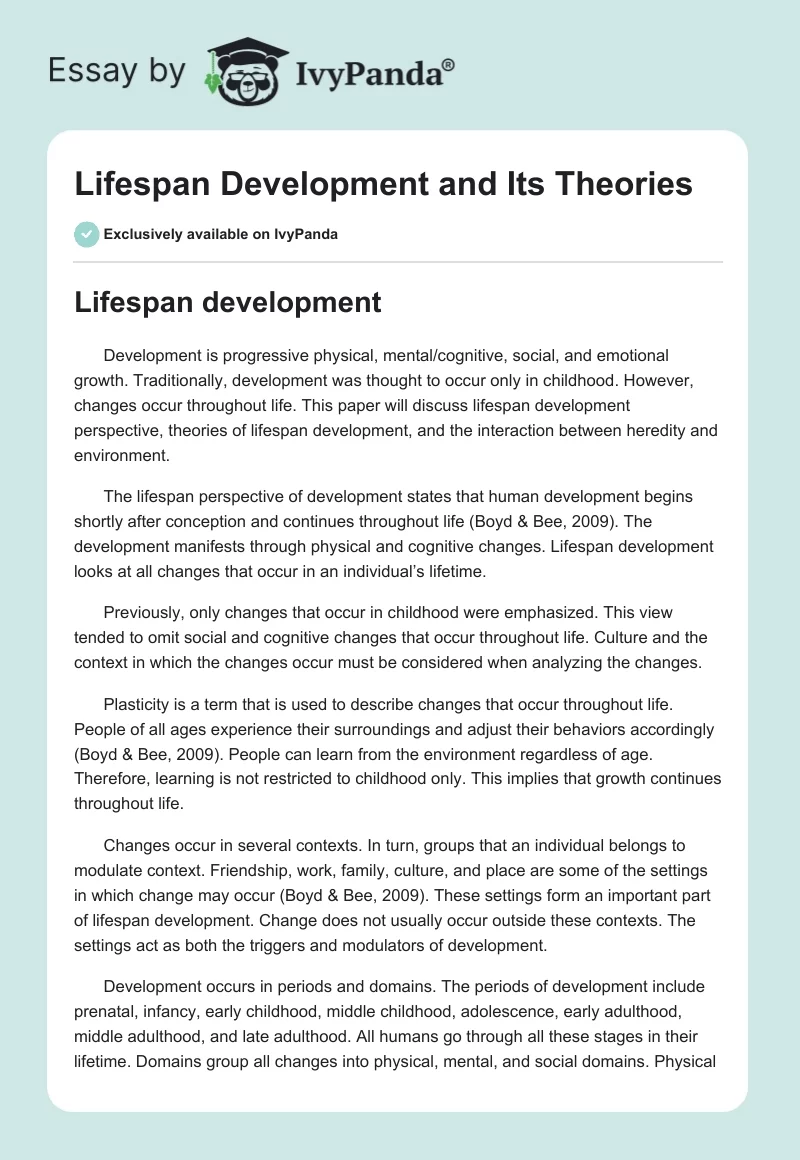Lifespan development
Development is progressive physical, mental/cognitive, social, and emotional growth. Traditionally, development was thought to occur only in childhood. However, changes occur throughout life. This paper will discuss lifespan development perspective, theories of lifespan development, and the interaction between heredity and environment.
The lifespan perspective of development states that human development begins shortly after conception and continues throughout life (Boyd & Bee, 2009). The development manifests through physical and cognitive changes. Lifespan development looks at all changes that occur in an individual’s lifetime.
Previously, only changes that occur in childhood were emphasized. This view tended to omit social and cognitive changes that occur throughout life. Culture and the context in which the changes occur must be considered when analyzing the changes.
Plasticity is a term that is used to describe changes that occur throughout life. People of all ages experience their surroundings and adjust their behaviors accordingly (Boyd & Bee, 2009). People can learn from the environment regardless of age. Therefore, learning is not restricted to childhood only. This implies that growth continues throughout life.
Changes occur in several contexts. In turn, groups that an individual belongs to modulate context. Friendship, work, family, culture, and place are some of the settings in which change may occur (Boyd & Bee, 2009). These settings form an important part of lifespan development. Change does not usually occur outside these contexts. The settings act as both the triggers and modulators of development.
Development occurs in periods and domains. The periods of development include prenatal, infancy, early childhood, middle childhood, adolescence, early adulthood, middle adulthood, and late adulthood. All humans go through all these stages in their lifetime. Domains group all changes into physical, mental, and social domains. Physical domain describes all the physical changes occurring in an individual. The mental domain is concerned with cognitive development. Social domain covers all social changes an individual experiences.
Attachment Theory/ Bowlby’s attachment Theory
The attachment theory states that human infants need an adult with whom they feel secure. Attachment provides the infant with emotional, physical, and psychological security. Attachment is an instinct that develops to ensure the safety of the infant. Body contact and familiarity strengthen attachment.
Various types of attachment exist; secure, anxious-avoidant, and anxious-resistant. Secure attachment is a desirable form of attachment. It is founded on trust. Anxious-avoidant and anxious-resistant forms of attachment are characterized by detachment. Healthy emotional and psychological development depends on attachment. If an infant’s ability to attach to parents or caregivers is restricted, the infant may develop feelings of anger and anxiety. These individuals may become overly aggressive during adulthood.
Theory of Perceptual Development/Gibson’s Theory
The theory of perceptual development states that infants are born with functional perceptual systems (Slater & Lewis, 2006). This implies that touch, smell, sight, sound, and taste sensations are present at birth. The perceptions play an important role in an infant’s survival. For example, infants are born with an innate preference for mother’s milk. The senses undergo age related changes and by the age of two years, most senses have fully developed. However, at birth touch appears to be the most developed.
Heredity and the environment
Heredity is a term used to describe human characteristics inherited from parents. Heredity also refers to nature. This includes all aspects of a human being controlled by genes. The genetic composition of an individual plays an important role in growth and development. Genes control all the metabolic processes that produce physical development. Genes influence height, weight, and physique. Genes code this predetermined traits.
However, the environment undoubtedly influences the expression of these genetic traits. For example, obesity may be common in places where food rich in fats and calories is regularly consumed. An individual may be genetically predisposed to certain cardiovascular diseases but in the absence of environmental modulation, the diseases do not develop. In most cases, some diseases are managed using lifestyle modulation. This indicates that environmental factors play a role in their development.
The environment modulates the effects of genes. The environment modifies all the genetically controlled processes. This produces unique traits that are not shared between individuals. However, the genes may also exert a modulating effect on the environment. The interaction between genes and the environment is complex and to some extent, the product is not predictable. Genetic makeup may influence people to prefer some environments. This implies that genes influence the choice of the environment.
The effect of the environment on identical twins has been studied and it revealed that some aspects of development are not greatly influenced by the environment. Related individuals share these aspects. Aspects that may be modified by the environment include learning and interests. Some environments facilitate quick acquisition of knowledge while others hinder it.
This paper discussed lifespan development perspective, theories of lifespan development, and the interaction between heredity and environment. The lifespan development perspective contends that development is continuous. Development is physical, emotional, or psychological change. The attachment theory states that infants need adults to feel secure. The perceptual theory states that perception plays an important role in developed.
References
Boyd, D. & Bee, H. (2009). Lifespan Development (5th ed.). Boston: Allyn & Bacon.
Slater, A. & Lewis, M. (2006). Introduction to Infant Development. Oxford: OUP.


